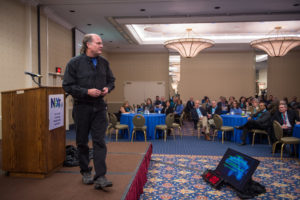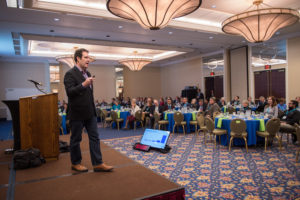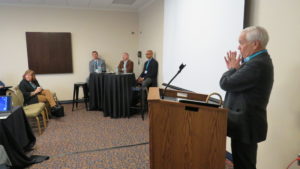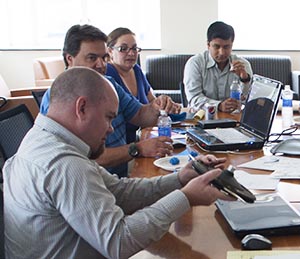It is evident when sitting in on a meeting of the College of Law’s Technology Commercialization Research Center (LAW 815) that there’s a reciprocal relationship between clients seeking help from student researchers in order to commercialize a new technology and students who are accumulating critical experience in intellectual property assessment, patent protection, market landscaping, and other commercialization matters.
Certainly, this was the case when the Research Center team met with entrepreneur Andrea Madho and software engineer Philip Manning G’98 in Dineen Hall on Jan. 16, 2018, to learn about a semester-long project the students will be conducting on behalf of Madho’s and Manning’s start-up fashion technology company, Lab141.

Now in its 25th year, the Research Center allows students from the College of Law and across campus to work on technology commercialization projects with entrepreneurs, companies, universities, and research centers from across New York State and to apply their classroom knowledge to real-world technology projects. This Research Center group is led by College of Law Adjunct Professor Dean Bell G’72, a former R&D engineer for 41 years at medical technology firm Welch Allyn who has been awarded nine US patents. Bell describes himself as the “coach” of the group of eight. His “quarterbacks” for the Lab141 project are Technology Commercialization Law Program (TCLP) senior research associates and 3Ls Annie Millar and Nick Jacobs, who is a joint J.D./M.B.A student.
Although Madho is a client rather than a teacher, her approach showed that she was eager to share her years of experience in business development, marketing, and strategic and financial consulting with the young researchers. As she told the students, “All my skills in public relations, technology, and raising money, I’m now using myself as an entrepreneur.”
The same is true for Madho’s skills in pitching an idea. At the core of this kick-off session was a deft, 10-slide “pitch deck” that she has been using to describe the idea behind Lab141 to stakeholders. Madho’s presentation begins with an honest description of her own travails finding clothes, especially designer and professional clothes, to fit her “short, plus-sized, high-waisted body type.”
As Madho explained, “Both men and women have problems finding clothes to fit. Even men have told me they are too short, too tall, too big, too lopsided, or their arms too long for off-the-rack clothes.” Because “regular” height, as far as women’s clothing is concerned, is 5 feet 5 inches to 5 feet 8 inches, most women are considered “specialty size,” with 67% of women deemed plus-sized and 56% either “tall” or “petite”. Today, the ubiquitous dress size code that goes from 0 to 14 is so arbitrary as to be meaningless, observed Madho. “We want to have no sizes ever!”
But whereas men at least can get suits and shirts made-to-measure at a traditional tailor, non-regular-sized women have few options when it comes to the designer and professional clothes market. Lab141’s solution is to offer advanced, technology-based manufacturing so that designers, retailers, and brands can offer ready-to-wear, made-to-measure garments direct to the consumer. As the company’s tag-line states, Lab141 offers consumers “luxury made-to-fit clothes in 48 hours.”
“Rather than create a brand for a certain body type,” explained Madho, “we chose to tackle made-to-measure clothes from a technological standpoint.” It’s then that Madho stands up, in order to show—rather than tell—the students what she means. She is wearing a wrap dress designed by their alpha customer that fits her perfectly. That’s because, she explained, it has been measured, mapped, and cut to her exact body measurements and fit preferences.
Her dress and a description of how it was fitted can been found on Lab141’s website. That site will be where consumers can purchase new designer clothes offered in a made-to-fit format. Madho says Lab141 plans to initially offer one designer piece per week. Because of the fast turnaround, a consumer sends in a slate of specific measurements first and then Lab141 uses those measurements to cut the dress to order, having already received patterns and fabric from the designer at the company’s Syracuse, NY, manufacturing location. After the order is fulfilled, the consumer can buy their purchase from the website.
To buy a bespoke item, Madho says the consumer can measure herself with a good old fashioned tape measure, or use an online measuring app, or purchase Lab141’s proprietary Fiteema system, a wearable measuring garment that Lab141 also will sell on its website. The brainchild of Manning, a former software engineer for Procter & Gamble, Fiteema uses embedded technology to measure many parts of the body useful for fitting clothes, such as neckline, waist position, slope of the shoulder, curve of the back, and so on. “Fitting and cutting clothes is all about Bezier curves and mapping the body,” Madho observed. “There’s a lot of math and science involved in ‘redimensioning’ clothes to fit a body exactly.”

Lab141’s technological approach to clothes manufacturing offers many advantages for designers who partner with Madho and Manning. They include access to a lucrative market of consumers of all body types, a more transparent supply chain, reduced inventory, and digital, analytical reports about fit and preference that can be shared with designers. All in all, explained Madho, Lab141 offers a better way for clothes designers to make money from an untapped market in an industry in which margins are small.
For their part, this cohort of LAW 815 students will perform several important business startup tasks for Lab141 as it continues to assess its chances of success in a competitive market. “We will offer a patent landscape, competitor analysis, market landscape, and trademark review,” explained Annie Millar. “The last one will be interesting because there’s been a number of design trademark issues in the clothing industry in the last year.”
“Working with clients such as Madho and Manning provides the TCLP students with a unique and exceptional experiential learning opportunity,” notes Bell. “This research experience and knowledge of entrepreneurship and tech commercialization often translates into successful careers. The clients benefit from unbiased, independent, thorough research and assessment of an emerging invention by very talented, multidiscipline students.”
Lab141 joins a long list of clients who have benefitted from the industriousness and skill of Research Center students in the last 25 years. That list includes projects on behalf of medical device, green building, and biotechnology companies and emerging technologies as varied as microelectromechanical systems, silicon membranes, smart windows, and the handling of metadata. In fact, TCLP—which in addition to the Research Center also directs the NYSTAR-designated New York State Science and Technology Law Center—has expanded its services over the last five years to keep pace with the growth of tech startups in the state.




